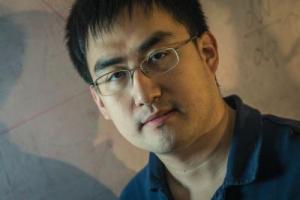May 19 2014
Rice University physicist Wei Li is searching for the smallest and hottest drop of soup in the universe, and thanks to a coveted Early Career Award from the Department of Energy (DOE), he'll have a chance to look for it beneath the Swiss Alps.
 This is Wei Li. Credit: Jeff Fitlow/Rice University
This is Wei Li. Credit: Jeff Fitlow/Rice University
The five-year grant will fund Li's research on "quark-gluon plasma" (QGP) at Europe's Large Hadron Collider (LHC). QGP, which is sometimes called "quark soup," is a liquid of subatomic particles that only appears at temperatures above 2 trillion kelvins.
DOE's Early Career Awards support the development of individual research programs of outstanding young scientists. The awards include some of the agency's most highly sought grants. About 750 people applied for the awards this year, and only 35 were selected. Li was one of just 18 chosen from the ranks of the nation's leading research universities. The other 17 were awarded to scientists from U.S. national laboratories.
Li's research specialty lies at the intersection of nuclear physics and high-energy particle physics. The new grant will allow him and his students to search for QGP at the LHC, the world's most powerful particle accelerator. Operated by the European Organization for Nuclear Research (CERN), the LHC is the laboratory that found the long-sought Higgs particle in 2012.
"We share exactly the same hardware as the folks who discovered the Higgs boson, but we are designing software to study a different type of physics," Li said.
Physicists have used particle accelerators to smash together atoms and subatomic particles for nearly a century. By accelerating tiny bits of matter to near light speed, physicists are able to imbue them with terrific amounts of energy. When two such particles meet in a head-on collision, their combined energy gets converted -- via Einstein's famous equation E=mc2 -- into mass. The upshot is that each particle accelerator collision produces a shower of massive, short-lived subatomic particles. By watching these exotic particles decay, physicists can learn about the fundamental makeup of everything we can touch and see.
For example, experiments in particle accelerators have revealed that the protons and neutrons inside every atomic nucleus are themselves made of smaller stuff called quarks. The strongest known force in nature, which is simply called the "strong force," binds three quarks together inside each proton and neutron. The carrier for the strong force is another subatomic entity called a gluon, which constantly shuttles between tightly bound quarks.
In the late 1990s, physicists at the Brookhaven National Laboratory on Long Island began using a new kind of particle accelerator called the Relativistic Heavy Ion Collider to smash together the nuclei of massive elements like gold and lead, each of which contain dozens of protons and neutrons. The collisions between these massive nuclei, or heavy ions, are hot enough to melt protons and make QGP, a frictionless liquid soup of free quarks and gluons that last existed in nature in the microseconds after the Big Bang.
"The LHC successfully recreated QGP by colliding heavy lead nuclei in 2010," Li said. "However, most people believed that proton-proton collisions would not be able to produce QGP because although they are about 30 times more powerful than heavy ion collisions, the protons are considerably less massive than heavy ions.
"The data are still inconclusive, but the discovery of a novel phenomenon in the data from early runs of proton-proton collisions at the LHC suggests that a tiny amount of QGP may have been produced," he said. "When the LHC restarts next year, the energy of the proton beams will be about double what it was last time, and there is a chance that we can confirm that QGP is being produced."
Li said another possibility is that LHC is producing a new, previously unobserved form of matter that only looks like QGP at first glance.
"We are entering an exciting new phase of discovery at LHC," he said. "The key is knowing what events to look for and designing the proper algorithms and software to find the collisions that are producing new physics."
Li's team, which will include a postdoctoral researcher and graduate students, must design software that's capable of identifying the proton-proton collisions at the LHC that could produce smaller volumes and a fraction of the size of QGP than could be observed at the Relativistic Heavy Ion Collider. He said studies of tiny QGP droplets could provide new clues about the fundamental properties of the universe.
"We estimate that the kinds of collisions we are looking for occur once in every 1 million collisions at the LHC," Li said.
Given that some tens of millions of collisions occur each second at the LHC, and that scientists can only capture and store data for a few hundred of those, the task for Li's team is to develop a set of algorithms and software capable of snagging and saving data about QGP-producing collisions in real time.
"This would be a different way to study QGP, and it could have important implications for our understanding of the strong force between quarks and gluons," Li said.